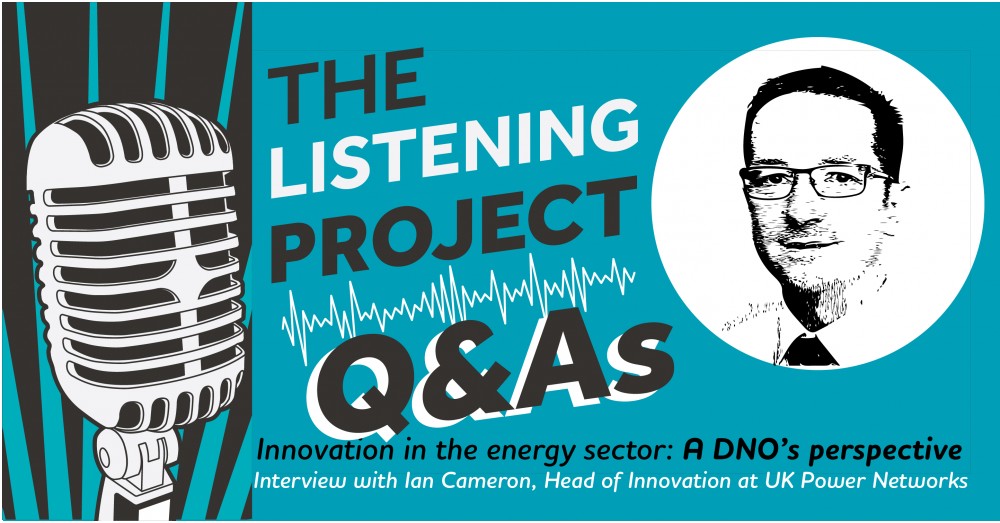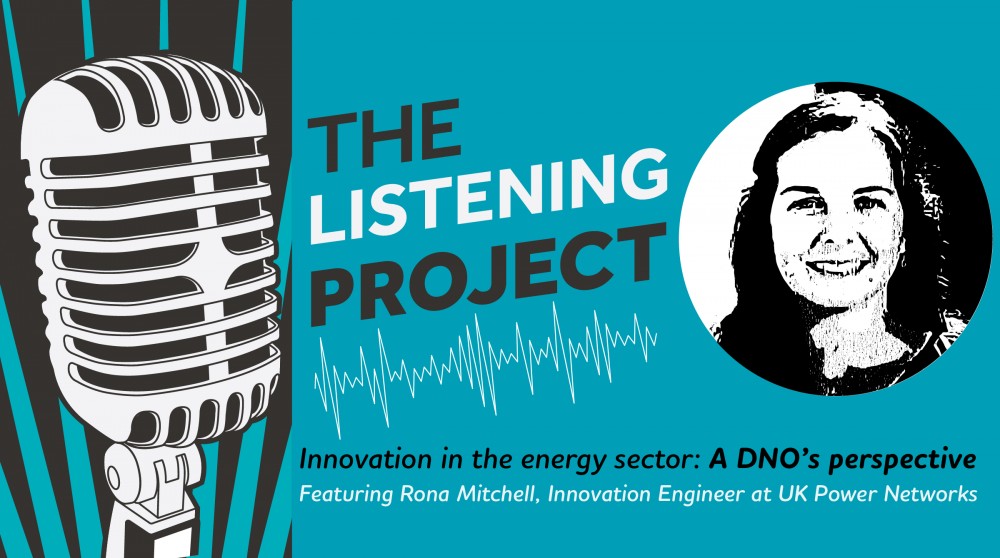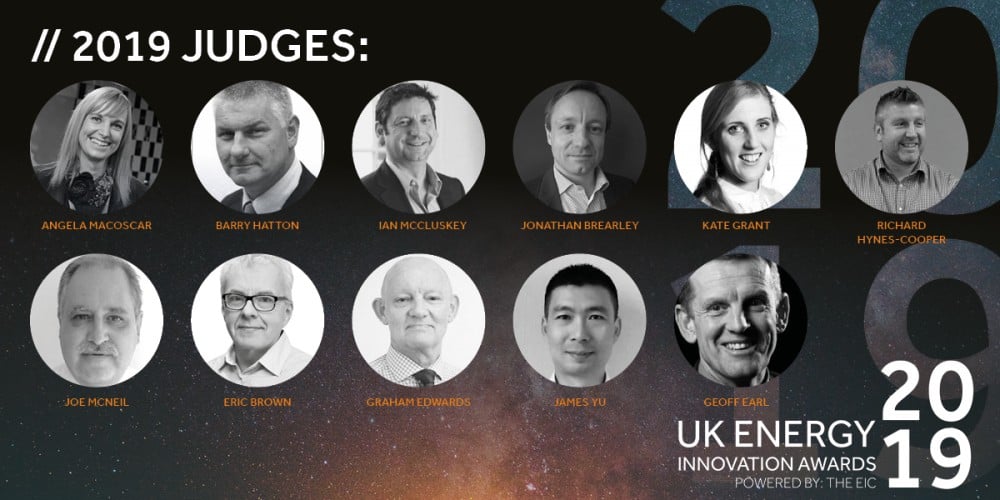From South Africa to the UK, Ian Cameron has spent the majority of his career working within the utility sector. With one key ambition in mind – developing renewable energy and increasing its presence across energy networks- he’s worked his way up from building substations, to taking on the well-deserved position of Head of Innovation at UK Power Networks (UKPN). One of Ian’s career highlights has been connecting around five gigawatts of renewable energy across the network, and he is continuously searching for ways to take things a step further. In an interview with the EIC’s Community Innovation Lead, Liam Bolton, he discusses DSOs, disruption, and UKPN’s preparations for the upcoming RIIO-2 framework.
Q. Tell us a bit about your role as Head of Innovation and what you’re looking to do, going forward.
Head of Innovation is really quite a broad term and I think that’s half of the appeal for me. I enjoy change, by nature, and the role can include anything from high engineering or developing a widget, right the way through to looking at new business models and understanding how they work- that’s where the DSO part of my work comes in. The role really gives me the ability to do the things I love in engineering but at the same time, I’m guiding policy and driving where the energy system’s going in the future. It’s really exciting.
Q. Could you tell us a bit more about UK Power Networks, your overall kind of jurisdiction, the areas you cover and your responsibilities?
At UK Power Networks, we’re one of six distribution network groups in the UK. We operate three licence areas: proudly London, so we usually have the opportunity to see things first in the capital; Eastern Power Networks, which is East Anglia; Southern Power Networks; and in total, about 8.2 million meter points. Around 20 million people, approximately a third of the population, are served by UK Power Networks. Something that I’m proud of is the volume of that which is renewable energy. We have nine gigawatts of distributed generation on our network and a total peak load of sixteen. This displays how nine out of sixteen, a high proportionality of the generation on our network, is actually utilised for our customers. Around seven gigawatts of these are renewable, which is a really great stat, especially considering the recent news surrounding Hitachi and the nuclear deal. These are the types of things that show you progress in the very short-term; you have distribution networks, historically built for top down generation, which will now be able to produce around 50% of peak load within five to seven years - that’s monumental! What I’m really proud of is that we didn’t leave one connection standing; anybody who wanted to connect, as a distributed generation connection to the distribution network, was connected.
Q. Could you tell us a bit about DSOs?
In terms of, ‘what is a DSO?’ I’m going to try and bring that back to layman terms. Ultimately the UKPN is a network business that manages assets; we install transformers and cables to transport energy from wherever it’s generated to your house. In the future, we’re going to have a high volume of decentralised energy. What that means is, for example, rooftop solar panels will be generating energy where you need it. The question here is how do you store that energy? The challenge that comes with a DSO is intermittency- so you may be able to generate energy when the sun’s shining but not when the sun goes down. With this, you then have a high level of uncertainty. You don’t want to generate too much energy or else you’ll waste it. So that balancing act is what a DSO would do; as a system operator, it’s a balance of load and generation, and that’s probably as simply as I can put it in layman terms. We are going to play a balancing role; we aren’t just going to be the motorway for energy; we’re going to become a bit of the tollgate, a little bit of the roadworks- the whole system operation.
The back office of a DSO is figuring out all of the systems and enablers that are needed. This is what UKPN are going through at the moment; building the right systems and products, developing these systems, and creating the right policies around them. We are trying to stimulate a market, which means we’ve got to put in a volume of effort in order to get people interested. This means bringing financial incentives various to that market, in order to unlock it.
Q. How will the consumer be impacted by the move to DSOs?
Ultimately, what it means for customers is that they will have the ability, if they have generation on their roof, to be able to pass energy on and sell it to their neighbours. It can be kept locally, so if you generate locally for your community, you deliver it locally for your community. There’s also the opportunity to earn more revenue through flexibility. The main challenge is that people have not been engaging with energy; they don’t really care and there’s a lot of research that supports that. There’s a challenge on us all, whilst we transition to this distribution system operator, to make sure we keep conveying the right message and that we’re bringing communities and customers along on the journey. There is onus on networks and all actors in that value chain to be able to make sure that the customers and consumers understand that message clearly and how it’ll benefit them. To do this, we have to try and bring the discussion back to what we call ‘in the life of’ and what that means for everybody at home going about their daily functions. How I try and explain this flexibility in this sense, is by saying, ‘You don’t need to do anything different. You still want to be warm, you still want to be able to watch telly, you still want to do all these things, but actually would you mind if your electric vehicle was charged at 3:00 in the morning rather than 9:00 the previous evening?’- That’s flexibility and that’s what we’re interested in.
Where networks are concerned, from a DSO point of view, we really want to deal with whoever’s going to manage that for the consumers, because they will be the ones holding that flexibility on their behalf. We believe there’s an emerging market here; there are a lot of people playing for that third party intermediary role. We’d love to see consumers trust and have somebody that generally cares for them, somebody that will hold their hand and walk them along the journey.
Q. What are some of the emerging trends in the industry and where should the innovators that the EIC work with be looking to focus their attention on in the coming years?
I think you can start to look at emerging trends from a point of disruption. A lot of the external speaking I do is about disruption in the energy system and a lot of the time there’s challenge that says we’re going to be disrupted. I would argue that we’ve been disrupted for about ten years, if you think about the volume of distributed generation we’ve connected. There are 160,000 generators connected to our network already. Therefore, you could almost argue that the model of traditional networks has been disrupted for some time. In terms of onset for storage, we’ve had thousands of connection applications for storage onto our network. We’re sitting at a high 200 megawatts of connected storage. So that’s generation storage.
You then start to bring on EVs, electric vehicles, and I think that’s where the big value lies in the future. Already, we spend a lot of time, as UK Power Networks, getting ourselves ready for electric vehicles; we work on developing strategy, products and solutions. Where I say the value lies moving forward, at least in the near term (five to ten years), is in products that help us on the low voltage network. Historically, you would invest in the first mile of the network which would be your transmission system - your high power, high voltage generators. With the current decentralisation of energy you start to see that your low voltage network, the cable that goes past your house in your street, becomes the first mile of your network. In terms of investing in that, you start to find products and spend money on those items where you most use that asset. The challenge then lies (and the challenge back out to all SME’s and suppliers in the market) in looking for products and solutions that are affordable. This is because, when you’re at the low voltage network, you’re talking about high volumes- you’re not talking about single products and high values, but instead about hundreds of thousands of products at very low cost. To contextualise that, UK Power Networks has 120,000 secondary sites (substations up your street) and each site has five feeders, which means there are five cables coming out, and each of those cables serves around 500 houses. You do the maths and you start to identify what solutions then need to look like- it’s about doing it en masse.
Q. How can SME’s and innovators with these products and innovations engage with UK Power Networks?
There’s multiple means. We have an innovation strategy- you can pop onto our website and have a look there as we publish our problem statements regularly. What we then also do is focus on the long-term horizon scanning. We’ve brought that near-term, trying to balance the fact that we want to deliver benefits in the current regulatory settlement, meaning solutions that are probably of a higher technology readiness level. This is important, as the people we then interact with are different. There starts to be a balance in engagement between small start-ups and supply chains. However, along with that comes a challenge, and the challenge is the ability to respond and service the idea or the third party that comes in and talks to us.
To tackle this, we set up key relationships, and one of them is with the EIC who take on that role for us; we issue the problem statements and then they’re able to interact with the third party market on a scale that we are not able to. This also brings a level of collaboration across networks. Imagine, from the point of view of a supply chain or an innovator, you have six networks to go to, plus your transmission. You need somewhere to go where you can say, ‘actually, I’ve got an idea, is anybody interested?’ or ‘what are the problems in general across networks that have scalability?’ The EIC enables networks to set expectations in a regulated world and provides opportunities and a platform for innovators. This includes helping them with, access to funding, building and co-creating their ideas to a point where a network could understand them.
Q. You mentioned your innovation strategy before. How do you compile and produce that, where do you start?
You’ve got to start with the customer journey. You’ve got to understand where your value is, and who you’re providing value to. At UKPN, I take the strategy on the road with my strategy manager, and together we talk to key customers, third parties and SME’s. We ask them, ‘what do you think we need?’ A lot of our strategic planning is usually set in whilst the current strategy is in place, so you are already starting to think, how can I make this better, what are the key focus areas and where’s the need? The way we did that last year was by separating these things into time-bound structures. Our strategy focuses very much on being efficient and effective; things that bring a high technology readiness solution. We then consider future readiness. That’s the DSO transition- you package all your solutions in that, develop those, and then you have your low carbon technology readiness, which is your electric vehicles, your heat pumps etc.
We set our strategy at that highest level, and we then structure our teams below it to be able to support it and work that strategy hard. What we then do is take that thinking and pop it through what we call our critical friends panel. These are members across the industry who will challenge us and, in a safe environment say, ‘you’ve left a section out’ or ‘you’ve left a market out.’ We then spend a lot of time taking their feedback and incorporating it, before putting it past our internal stakeholders. To me, the value of innovation is in developing the ideas and the products and then trialling them. The challenge that remains then is for innovators, in various markets, to take that solution and move it into what we call ‘business as usual’.
Q. Could you tell us what RIIO-2 is, and how you’re going about preparing for it?
Ultimately, it’s a regulatory framework that says you get your revenue as a business through a combination of incentives- so do the right things, perform well and then you’ll then be incentivised. So that’s the first I (in RIIO). The second I is innovation - proving that you’re able to innovate. There are returns there if you outperform your settlement through innovation. Finally, the O is simply the outputs; deliver the outputs you said in your plan. I must add, I’ve worked in a few countries and it’s probably the best regulatory framework, in the world, that I’ve worked within yet. This is because it brings great value to customers, networks and shareholders.
In terms of readiness for RIIO-2, I don’t remember a time that we’ve ever gotten 50% of the way through the current settlement before we’ve started thinking about what the next framework, in our case ED2 or in the case of the wider networks RIIO-2, looks like. At this point, our main role is to support and get involved in the discussion. We also need to make sure that we don’t get into a situation where deals are being done or have been struck already from the system; we need to talk about the wider system as a whole and that, in my opinion, crosses gas and electricity. Let’s not leave any decisions, made or unmade, that potentially could affect distribution networks in the future. We are spending a lot of time trying to ensure we get the right settlement for all networks and customers. In innovation, specifically, my role now is to make sure that I have a suitable volume of solutions in the ED1, which will then start to flow over into ED2.
Q. What advice would you give to those looking to innovate within the sector and the smaller companies we work with?
Firstly I’d say welcome and that it’s buoyant. There’s a huge amount of funding in the UK; between the regulators, the government and private investment- it’s a fantastic place to be. I was in Japan recently and they’re looking to follow a similar model. They sit in a scenario where it’s very hard for somebody to have an idea and actually access funding to deliver and trial it on a real network- it’s just not heard of in Japan. If you think about the stimulus pack, just under the various ones in the regulated sector, you’ve got network innovation allowance which is, in our case, half a percent of our revenues every year. This equates to about £8 million that we are given to try new things. The value there, and why it’s regulated, is that 75% of that NIA money doesn’t go to our business. It’s going external; it’s stimulating market and providing an avenue for those who have ideas, to be able to deliver them through the likes of the EIC. UKPN is always open for business and the EIC is a fantastic vehicle to be able to access various networks. Networks want to collaborate in this space and they use vehicles like the EIC to do that. We are able to part-fund projects in order to carry out demonstrations, on multiple networks, which then get speed of product into ‘business as usual’ or at least into market a lot quicker.
My final message would be to keep trying- if you aren’t being heard, shout louder. Come and see us on the networks personally and give it a go.









